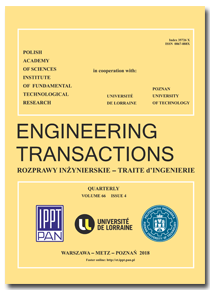10.24423/engtrans.94.2013
Parametric Study of Numerically Modelled Delamination Process in a Composite Structure Subjected to Dynamic Loading
References
Ochelski S., Bogusz P., Kiczko A., Static axial crush performance of unfilled and foamed-filled composite tubes, Bulletin of the Polish Academy of Sciences Technical Sciences, 60, 1, 31–35, 2012.
Zangani D., Robinson M., Gibson A.G., Progressive Failure of Composite Hollow Sections with Foam-Filled Corrugated Sandwich Walls, Appl. Compos. Mater., 14, 325–342, 2007.
Tekalur S.A., Shukla A., Shivakumar K., Blast resistance of polyurea based layered composite materials, Composite Structures, 84, 271–281, 2008.
Gama B.A., Gillespie J.W. Jr., Finite element modeling of impast, damage evolution and penetration of thick-section composites, International Journal of Impact Engineering, 38, 181–197, 2011.
Xiao J.R., Gamma B.A., Gillespie J.W. Jr., Progressive damage and delamination in plain weave S-2 glass/SC-15 composites under quasi-static punch-shear loading, Composite Structures, 78, 182–196, 2007.
Barenblatt G.I., The formation of equilibrium cracks during brittle fracture: general ideas and hypotheses axially symmetric cracks, Appl. Math. Mech., 23, 622–36, 1959.7. Dugdale D.S., Yielding of steel sheets containing slits, J. Mech. Phys. Solids, 8, 100–4, 1960.
Leonov M.Y., Panasyuk V.V., The micro cracks development in a solid [in Ukrainian], Prikladnaya Mekhanika, 5, 391–401, 1959.
Valoroso N., Champaney L., A damage-mechanics-based approach for modelling decohesion in adhesively bonded assemblies, Engineering Fracture Mechanics, 73, 2774–2801, 2006.
Sevkat E., Liaw B., Delale F., Raju B.B., A combined experimental and numerical approach to study ballistic impact response of S2-glass fiber/toughened epoxy composite beams, Composites Science and Technology, 69, 965–982, 2009.
Hufenbach W., Langkamp A., Hornig A., Zscheyge M., Bochynek R., Analysing and modelling the 3D shear damage behaviour of hybrid yarn textile-reinforced thermoplastic composites, Composite Structures, 94, 121–131, 2011.
Kushch V.I., Shmegera S.V., Mishnaevsky L. Jr., Explicit modeling the progressive interface damage in fibrous composite: Analytical vs. numerical approach, Composites Science and Technology, 71, 989–997, 2011.
Hashin Z., Failure Criteria for Unidirectional Fiber Composites, J. Appl. Mech., 47, 2, 329–335, 1980.
LS-Dyna Keyword User’s Manual Volume I, February 14, 2012 (revision: 1197), Version
, Livermore Software Technology Corporation (LSTC).
Gerlach S., Fiolka M., Matzenmiller A., Modelling and analysis of adhesively bonded joints with interface elements for crash analysis, Konferenzbeitrag zum 4. LS-DYNA FORUM, Bamberg, DYNAmore GmbH, Stuttgart, October 20–21, 2005.
Hallquist J.O., LS-Dyna Theory manual, March 2006, Livermore Software Technology Corporation (LSTC).
DOI: 10.24423/engtrans.94.2013




